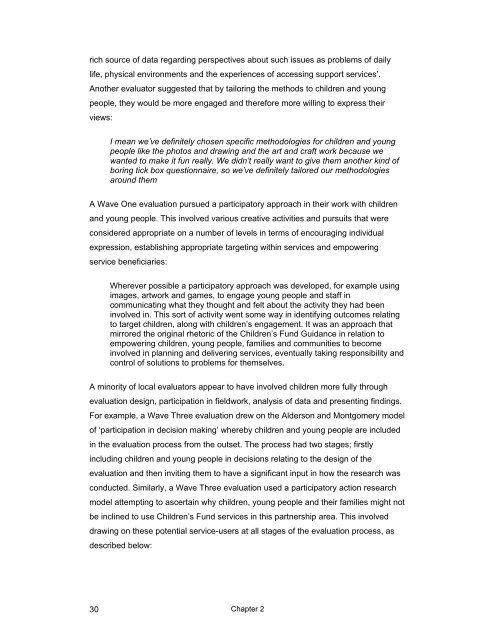Local Evaluation of Children's Services Learning from the Children's ...
Local Evaluation of Children's Services Learning from the Children's ...
Local Evaluation of Children's Services Learning from the Children's ...
- No tags were found...
You also want an ePaper? Increase the reach of your titles
YUMPU automatically turns print PDFs into web optimized ePapers that Google loves.
ich source <strong>of</strong> data regarding perspectives about such issues as problems <strong>of</strong> dailylife, physical environments and <strong>the</strong> experiences <strong>of</strong> accessing support services’.Ano<strong>the</strong>r evaluator suggested that by tailoring <strong>the</strong> methods to children and youngpeople, <strong>the</strong>y would be more engaged and <strong>the</strong>refore more willing to express <strong>the</strong>irviews:I mean we’ve definitely chosen specific methodologies for children and youngpeople like <strong>the</strong> photos and drawing and <strong>the</strong> art and craft work because wewanted to make it fun really. We didn’t really want to give <strong>the</strong>m ano<strong>the</strong>r kind <strong>of</strong>boring tick box questionnaire, so we’ve definitely tailored our methodologiesaround <strong>the</strong>mA Wave One evaluation pursued a participatory approach in <strong>the</strong>ir work with childrenand young people. This involved various creative activities and pursuits that wereconsidered appropriate on a number <strong>of</strong> levels in terms <strong>of</strong> encouraging individualexpression, establishing appropriate targeting within services and empoweringservice beneficiaries:Wherever possible a participatory approach was developed, for example usingimages, artwork and games, to engage young people and staff incommunicating what <strong>the</strong>y thought and felt about <strong>the</strong> activity <strong>the</strong>y had beeninvolved in. This sort <strong>of</strong> activity went some way in identifying outcomes relatingto target children, along with children’s engagement. It was an approach thatmirrored <strong>the</strong> original rhetoric <strong>of</strong> <strong>the</strong> Children’s Fund Guidance in relation toempowering children, young people, families and communities to becomeinvolved in planning and delivering services, eventually taking responsibility andcontrol <strong>of</strong> solutions to problems for <strong>the</strong>mselves.A minority <strong>of</strong> local evaluators appear to have involved children more fully throughevaluation design, participation in fieldwork, analysis <strong>of</strong> data and presenting findings.For example, a Wave Three evaluation drew on <strong>the</strong> Alderson and Montgomery model<strong>of</strong> ‘participation in decision making’ whereby children and young people are includedin <strong>the</strong> evaluation process <strong>from</strong> <strong>the</strong> outset. The process had two stages; firstlyincluding children and young people in decisions relating to <strong>the</strong> design <strong>of</strong> <strong>the</strong>evaluation and <strong>the</strong>n inviting <strong>the</strong>m to have a significant input in how <strong>the</strong> research wasconducted. Similarly, a Wave Three evaluation used a participatory action researchmodel attempting to ascertain why children, young people and <strong>the</strong>ir families might notbe inclined to use Children’s Fund services in this partnership area. This involveddrawing on <strong>the</strong>se potential service-users at all stages <strong>of</strong> <strong>the</strong> evaluation process, asdescribed below:30Chapter 2
















